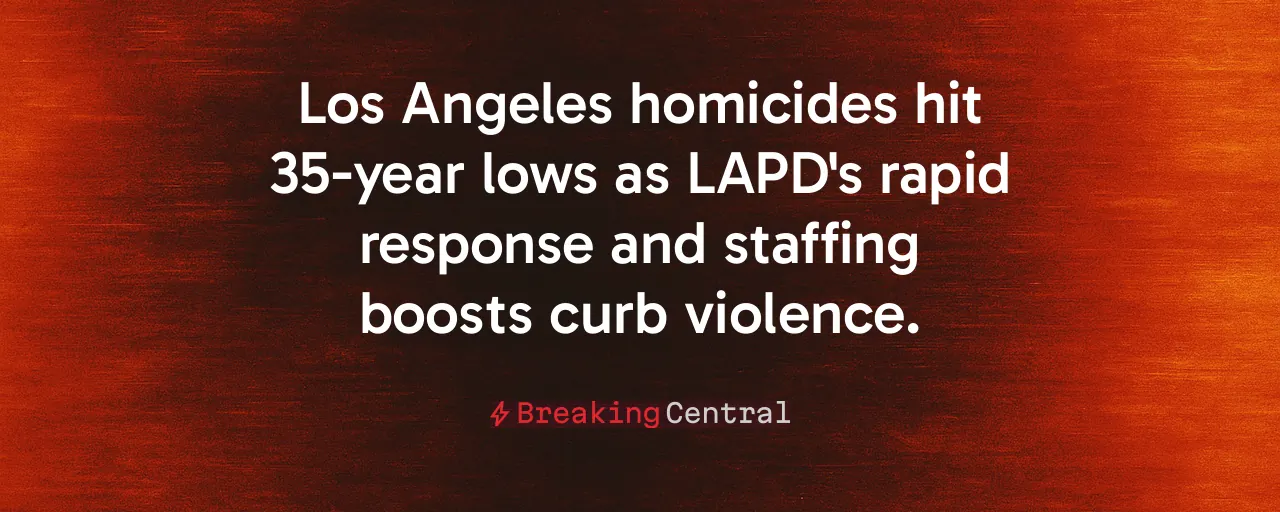A Historic Turn for Los Angeles
Los Angeles is witnessing a remarkable shift. Mayor Karen Bass announced in July 2025 that homicides are on pace to hit their lowest mark since 1968, with only 116 recorded through late June. This 20 percent drop from last year signals a city reclaiming control over its streets. The Los Angeles Police Department's renewed focus on rapid response and targeted arrests deserves much of the credit. While lives are being saved, residents still face smash-and-grabs and retail theft, leaving many questioning if safety is truly within reach.
This milestone arrives after years of turbulence. The early 2020s saw violent crime spike, with homicides climbing past 400 in 2021. Businesses shuttered, families fled, and neighborhoods felt abandoned. The current decline, mirrored in cities nationwide, suggests a return to strategies that work. For Angelenos, it's a chance to rebuild trust in their city's ability to protect them, but only if leaders double down on what's driving this progress.
Policing Takes Center Stage
The numbers tell a clear story. LAPD has added roughly 400 officers since its 2022 low, bringing sworn strength closer to 9,000. Patrols in areas like Encino have disrupted burglary sprees, proving boots on the ground make a difference. Bass's hiring incentives and support for recruitment have begun to reverse years of staffing declines. The presence of visible and empowered officers makes criminals hesitate, ensuring they can respond effectively when a call comes in.
With retirements looming, the city needs to keep hiring to hit a target of 9,500 officers, a level many argue is essential for sustained safety. Contrast this with the 2020-2022 period, when reduced patrols and hesitancy in enforcement left gaps for crime to fester. National data backs this up: cities that maintained or increased police presence after 2020 saw faster declines in murder rates. Los Angeles's turnaround shows that proactive policing, paired with accountability for offenders, cuts through the chaos.
Community Programs Play a Supporting Role
Bass has emphasized prevention, pointing to programs like Gang Reduction and Youth Development, now housed under her Office of Community Safety. These efforts, including Summer Night Lights, engage youth in high-risk areas, offering alternatives to gang life. Data shows gang-related homicides fell 45 percent in targeted zones since 2023. These programs matter, but their impact hinges on a foundation of law enforcement. Without police to deter violence, community outreach alone struggles to hold ground.
Residents in Watts or South Los Angeles, where violence once ruled, feel the difference. Fewer shootings mean less trauma for families and kids. But prevention's success is fragile. Funding for these initiatives needs to be consistent, and coordination with police is non-negotiable. The Urban Peace Institute and similar groups provide critical support, yet law enforcement remains essential when a gang member pulls a trigger.
Lingering Threats Require Bolder Action
Despite the homicide drop, property crimes like retail theft and smash-and-grabs plague businesses and erode public confidence. State laws, such as Proposition 47, which reduced penalties for theft and drug offenses, have emboldened repeat offenders. A 2025 retail-theft package signed into law aims to crack down, serving as a start rather than a complete solution. Business owners in places like Melrose or Downtown Los Angeles report ongoing losses, with some closing shop altogether. This situation does not align with the safety residents were promised.
Then there's the issue of repeat offenders. Zero-bail policies and lenient sentencing allow career criminals to cycle through the system. The Los Angeles County District Attorney's Office needs to prioritize swift prosecution for violent and serial offenders. Restoring cash bail and amending Proposition 47 to address fentanyl and theft could close these loopholes. Federal cooperation, including with immigration enforcement, would also help target gang networks driving crime in vulnerable neighborhoods.
Lessons From the Past
Los Angeles has been here before. In 1968, the city recorded 349 homicides, a low before the crack epidemic and gang wars of the 1980s sent killings soaring past 1,000 by 1992. The decline through the 2000s, driven by data-driven policing and gang intervention, brought homicides to 260 by 2017. The pandemic, economic upheaval, and social unrest undercut gains, peaking at 402 in 2021. Today's progress builds on those earlier lessons: consistent policing and targeted prevention save lives.
Scholars also warn that homicide counts can be volatile. Transparency in how deaths are classified and reported is critical to ensure the public trusts the data. Los Angeles's history shows that letting up on enforcement invites a rebound. The city can't afford to repeat that mistake.
A Blueprint for Lasting Safety
Los Angeles stands at a crossroads. The homicide decline proves that robust policing, backed by strategic prevention, delivers results. LAPD's hiring push needs to continue to counter retirements and meet the city's needs. State lawmakers can build on the 2025 retail-theft laws by tightening penalties for fentanyl and property crimes. Gang injunctions and broken-windows enforcement, once controversial, merit a second look for their proven ability to disrupt crime patterns.
Residents, from business owners to families in high-risk neighborhoods, deserve a city where safety is a tangible reality, not merely a headline. Community programs like GRYD and Summer Night Lights can expand, provided they operate alongside a fully staffed police force. Joint partnerships, pairing officers with civilian violence interrupters, offer a model for trust-building without sacrificing accountability. Transparency, through public crime dashboards, will keep everyone honest.
The approach involves prevention and policing working together, recognizing that one enables the other. Los Angeles has a chance to lock in these gains for decades, but only if leaders act with urgency. The data is clear, the path is tested, and the stakes are too high to waver. The city's future depends on getting this right.
